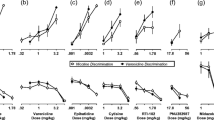Abstract
The discriminative stimulus (cue) property of nicotine was studied in a T-maze paradigm, and the results were analyzed by a new statistical method. For rats trained on 0.4 mg/kg, the ED50 was 0.11 mg/kg. The enantinomer of natural nicotine (+)nicotine was much less potent, and both position isomers of nicotine were inactive. Anabasine, which is active at nicotinic cholinergic receptors, provided the nicotine cue. Cytisine, a potent nicotinic agonist in vitro, was ineffective after SC administration and this was shown to be due to its inability to enter the brain in adequate amounts. High doses of cytisine by the intracerebroventricular route partially provided the cue. The cue was blocked by low doses of mecamylamine and pempidine and by high doses of hexamethonium. The data indicate that the cue receptor is pharmacologically similar to the nicotinic cholinergic receptor in autonomic ganglia.
Similar content being viewed by others
References
Barlow RB, McLeod LJ (1969) Some studies on cytisine and its methylated derivatives. Br J Pharmacol 35:161–174
Brown DA (1980) Locus and mechanism of action of ganglion-blocking agents. In: Kharkevich DA (ed) Pharmacology of ganglionic transmission. Handbook of Experimental Pharmacology, vol 53. Springer, Berlin Heidelberg New York, pp 185–235
Chance WT, Kallman MJ, Rosecrans JA, Spencer RM (1978) A comparison of nicotine and structurally related compounds as discriminative stimuli. Br J Pharmacol 63:609–616
Haefely W (1974) The effects of various nicotine-like agents in the cat superior cervical ganglion in situ. Naunyn-Schmiedeberg's Arch Pharmacol 281:98–117
Haglid F, Wellings I (1963) Synthetic analogues of nicotine. II. Acta Chem Scand 17:1737–1734
Hansson E, Schmiterlöw CG (1962) Physiological disposition of 14C-labeled nicotine in mice and rats. J Pharmacol Exp Ther 137:91–102
Hirschhorn ID, Rosecrans JA (1974) Studies on the time course and the effect of cholinergic and adrenergic receptor blockers on the stimulus effect of nicotine. Psychopharmacology 40:109–210
Jaffe JH (1975) Drug addiction and drug abuse. In: Goodman LS, Gilman A (eds) The pharmacological basis of therapeutics. Macmillan, New York, pp 325–358
Jarvik ME (1973) Further observations on nicotine as the reinforcing agent in smoking. In: Dunn WL (ed) Smoking behavior: Motives and incentives. Winston, Washington DC, pp 33–49
Meltzer LT, Rosecrans JA, Aceto MD, Harris LS (1980) Discriminative stimulus properties of the optical isomers of nicotine. Psychopharmacology 68:283–286
Milne MD, Rowe GG, Somers K, Muehrcke RC, Crawford MA (1957) Observations on the pharmacology of mecamylamine. Clin Sci 16:599–614
Overton DA (1966) State-dependent learning produced by depressant and atropine-like drugs. Psychopharmacologia 10:6–31
Overton DA (1969) Control of T-maze choice by nicotinic, antinicotinic, and antimuscarinic drugs. Proc. 77th Annual Convention, Am. Psychol. Assoc., pp 869–870
Romano C (1981) Nicotine action on rat colon. J Pharmacol Exp Ther 217:828–833
Romano C, Goldstein A (1978) Nicotine as a discriminative cue in rats: Isomeric specificity. Soc Neurosci Abstr 4:501
Romano C, Goldstein A (1980) Stereospecific nicotine receptors on rat brain membranes. Science 210:647–650
Rosecrans JA, Chance WT (1977) Cholinergic and non-cholineric aspects of the discriminative stimulus properties of nicotine. Adv Behav Biol 22:155–185
Russell MAH (1976) Tobacco smoking and nicotine dependence. In: Gibbins RJ, Israel Y, Kalant H, Popham RE, Schmidt W, Smart RG (eds) Research advances in alcohol and drug problems. Wiley, New York, pp 1–47
Schechter MD, Rosecrans JA (1972) Nicotine as a discriminative cue in rats: Inability of related drugs to produce a nicotine-like cueing effect. Psychopharmacologia 27:379–387
Schechter MD (1973) Transfer of state-dependent control of discriminative behaviour between subcutaneously and intraventricularly administered nicotine and saline. Psychopharmacologia 32:327–335
Tsujimoto A, Nakashima T, Tanino S, Dohi T, Kurogochi Y (1975) Tissue distribution of 3H-nicotine in dogs and rhesus monkeys. Toxicol Appl Pharmacol 32:21–31
Turner DM (1975) Influence of route of administration on metabolism of 14C-nicotine in four species. Xenobiotica 5:553–561
Author information
Authors and Affiliations
Rights and permissions
About this article
Cite this article
Romano, C., Goldstein, A. & Jewell, N.P. Characterization of the receptor mediating the nicotine discriminative stimulus. Psychopharmacology 74, 310–315 (1981). https://doi.org/10.1007/BF00432737
Received:
Accepted:
Issue Date:
DOI: https://doi.org/10.1007/BF00432737




